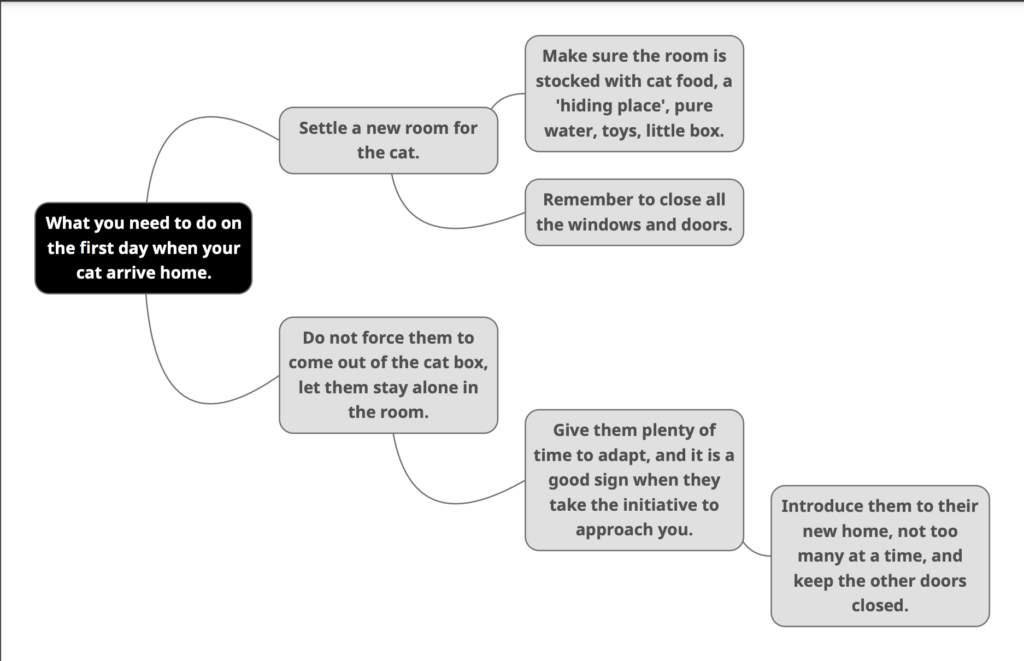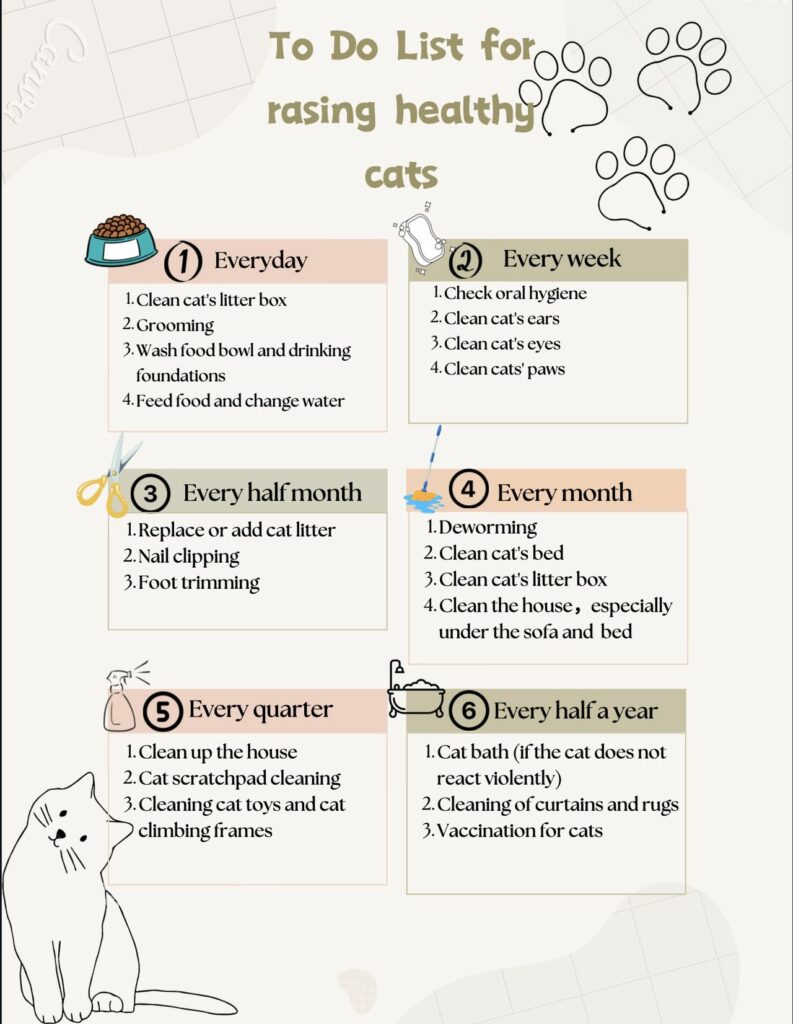
Learning Outcomes
- By the end of this content, learners should be able to do the following:
- Familiarize the five stages of cat ownership
- Understand the basic skills needed to own a cat
- Learn how to deal with cats on a daily basis
- Discover what to do with your cat during special times like worming and vaccination
Introduction
This project is to develop a learning lesson for new cat owners to correctly manage raising your cat. Learners will be given instructions at first with the basic knowledge and are going to need to perform hands-on activities that stimulate their learning process. The learners will need to interact with the hands-on learning activities to adopt new skills suitable for raising a cat, to have the learners experience both instructive and experiential learning. The lesson consists of learners learning it by themselves or better with a cat in their hand since some activities might be experimental and are better if you have a cat around. Let’s get started then!
1. Necessary items to prepare before picking up the cat
The first thing to do with a new cat arriving home is getting home set up. A brand new environment for cats means a safe home, especially when on the first visiting home. So, to help get cats feeling better in a brand new home, here are the things that we have to prepare first:
- Food: some cats food, cats snacks, water
There are many options for cat food, depending on different brands with different prices. With cat food, you could buy a food bowl for cats or it could be your used plate based on your budget, also a water bowl is necessary. For rewards, you can prepare some cat treats, which could be super attractive to cats, and it helps calm them down and get used to a new environment. It also could be a small piece of cooked beef, chicken or fish, or cat snacks.
- Cat litter box
Cats need to urinate, as a member of your family, a bathroom is also necessary. If your cat is normally at home, cat litter could be recommended. Cats are clean, they would cover their poops with cat litter, all you need to do is replace with new litter once in a while, depends on how much your cat costs.
- Bed: cushy bed
For better sleeping, a warm and soft bed is recommended. It could be a used pillow or hand made bed, as long as your cat feel safe and comfortable in it.
- Cleaning tools: Cat litter scoop, grooming brush, toothbrush (not a necessity for a kitten), nail clipper
To keep your cat clean, you may need kits for a safer environment, some cats could be sensitive to environment, so it is also a good thing to keep your cat clean.
- Entertainment: toys
For entertainment, you could choose whatever might attract cats’ attention. A laser pen with red dots will be attractive to most cats, they can not help chasing it, so have fun with little toys with your cats.
2. What do you need to do on the first day when your cat arrives home?
When you bring your cat home on the first day, they are easily stressed because it is a completely new environment for them. Therefore, owners need to pay attention to many things.
First of all, they will feel more secure by bringing them home in a cat carrier. According to each cat’s different personality to determine what kind of environment they need, for example, a shy cat will need a quieter room. Be careful not to force the cat to come out, open the cat cage and let them come out by themselves. Prepare the items needed for the cat in the room, such as litter box, cat food, water, cat bed, blankets, toys, etc.
Get along with the cats according to their behavior. If the cat hides or does not want to contact with you, please give them more time and prepare a hiding place for them. If the cat is willing to spend time with you, you can try to make contact with them and open the door to introduce them to their new home. Also, remember to put away any plants, decorations, etc. that are dangerous or harmful to the cat, and keep the doors and windows closed. Please do not be anxious and let the cat have enough time to adapt to the new environment by itself.
BATTERSEA is a website for dogs and cats where you can find much information related to cat raising. Below are articles and videos from BATTERSEA on how to set up a room on the first day your cat arrives home, with more detailed information on what to look for and how to handle different situations.

3. The daily routine of cat ownership
After the initial acclimation period, cats are mostly alone in their owners’ homes during the day. A cat’s daily activities include sleeping, eating, drinking and playing. Cats spend the majority of their time sleeping, but they also need to play and exercise a lot to maintain their physical and mental health. Cats prefer consistent feeding times and can occasionally become restless if they don’t receive food or attention when they anticipate it. By establishing a healthy and appropriate routine for your cat, the cat can thrive while growing into becoming a reliable companion.
Things to do every day:
- Feed: clean your cat’s dishes, then add food and clean water
- Clean the cat toilet: pay attention to whether the feces are normal
- Play: half an hour every day
- Groom: once a day
- Observe: observe your cat to see if there is any abnormality, such as eyes, ears, nose, chin and mental state
- Snack reward: give your cat a treat
In addition, here is a PowerPoint presentation on how to pet a cat, so that the viewer can learn how to approach and touch almost any cat without stressing the cat animal out.
How to pet a cat? by Zhuoheng Liu
4. Precautions
- Clean the litter tray: observe the colour and shape of the poo in order to understand the cat’s health problems. In this video, Dr. Sarah Wooten shares tips for understanding the color, shape, and consistency of your cat’s poop.
- Grooming: Cats like to lick their hair to clean themselves up. If they are not groomed, their intestines will not be able to digest the hair over time and they will be prone to hairballs, so make sure they are groomed daily.
- Change the water/food regularly: you can change the water and food once a day to reduce bacterial growth.
- Nail cutting: Cut your cat’s nails once every half month to avoid their nails being too long and scratching others, but be careful not to cut into the blood and flesh of your cat’s nails.
- Bathing: Cats should not be bathed when they first arrive in a new environment and are prone to severe stress reactions. In fact, cats do not need both, they have a strong self-cleaning ability and the cat will clean itself by licking its hair.
In this video, Dr.Sarah Wooten talked about “Should you bathe your cat”. You can find out from this video whether or not cats should be bathed, which situations necessitate a bath, and how to pull off a successful cat bath.
- Safety:
- If you live in an apartment or house, please make sure that the windows of your home are closed or screened when open. To prevent your cat from accidentally falling in while playing near the window or sneaking out without the owner knowing, make sure to double check the security of the window. Cats are very smart, don’t let them see how you open the window, otherwise some cats will secretly open the window and sneak out.
- There are many plants and human food that are toxic to cats and can cause death in severe cases, for example lilies are extremely toxic to cats and can cause acute renal failure. These human snacks are toxic to cats, and make sure you store these foods not meant for your cat in a place they can’t get to them:
- Chocolate
- Grapes and raisins
- Onions and garlic
- Macadamia nuts
- Bread dough
- Alcohol
- Xylitol, and artificial sweetener found in sugar-free gum and candy
- In addition, cats like to play with string, such as wires and wool. but they can easily accidentally eat them while playing, so owners should be careful to avoid accidental swallowing while they are playing.
5. Worming and vaccination issues
In this section, we will walk through how to deal with regular infections and how to vaccinate and prevent diseases for cat.
- Worming Precautions: having worms is a normal phenomenon for pets, the three most common worms are roundworm, hookworm, and tapeworm.
- roundworms: Most common ones in kittens at a young age (before 8 weeks)
- hookworms: not as common as roundworms, and a cat can be infected by hookworm by eating eggs.
- tapeworms: most often transmitted to cats by fleas and eating things with tapeworm egg on it, for example rats and mice, are usually for older cats.
- Vaccinations Procedures
Vaccines helps to protect cats from different diseases it will face in its periods of growth. Thus knowing when and what to vaccinate are really important. There are two basic types of vaccines for cats, which are FVRCP and rabies.
FVRCP vaccines and rabies are the two most common cat vaccines. FVRCP vaccines provide essential problems a cat needs to face all the common diseases it would have during its growth period, rabies are too common in mammals so some states in US even have laws to force owners to have rabies on their cats.
The kitten vaccination schedule usually contains about three visits, each visit has its own different purposes.
First visit is to examine the nutrition and grooming, the second visit is mainly for examination of parasites, the third visit is for rabies, with all three visits containing one or more doses of essential vaccines for the cat.
Here is a link to my powerpoint with a description of the procedures for worming and vaccination in detail along with some visuals.
Vaccination and worming for cat– by Bruce
Conclusion
In developing the lesson for new cat owners to correctly manage raising your cat, we applied and connected some theories and principles in different phases.
Phase 1
For introducing preparation before picking up, the segmenting principle has been followed. We put preparation into different parts including food, bed, cleaning, etc. It would give audiences time to process and store content by having little breaks, which are images of cat interactions mostly. Also, since images have been largely covered through all the introductions, multimedia principle has always been kept too, it gives text and image in presentation but not in text only.
Phase 2
We used the Signaling Principle by bolding the key information to emphasize what the owner needs to pay special attention to on the first day the cat comes to its new home.
Phase 3
In the PowerPoint “how to pet a cat”, we used Cognitive load theory (remain only 1 idea per slide and put no more than 6 objects per slide), Segmenting Principle (keep it short), Redundancy principle (don’t read the text of the slide and remove the draft below), Signaling principle (add visual elements), and coherence principles (focus on learning outcomes).
Phase 4
In the infographic “how to cut a cat’s nail in the right way”, we used the redundancy principle, Coherence principle and Contiguity principle of Mayer’s Principles.
Phase 5
We used the continuity principles to help the ready to enhance their knowledge by putting relevant pictures beside the point. For example, I put the pictures of the different types of worms cats might get each beside the name of these worms.
Moreover, we made use of PowerPoint, infographics, and other multimedia to guarantee that our learning objectives were achieved. We hope that the learners of this course can learn with a cat, take the initiative to learn at different stages, and become qualified cat owners.
To Do List

References
Reference:
Animal hospital, sharon lakes. (2020, June 15). Cat vaccinations: When and why indoor cats should be vaccinated. Cat Vaccinations: Why and When Indoor Cats Should Be Vaccinated | Charlotte Vet. Retrieved December 3, 2022, from https://www.sharonlakes.com/site/blog-south-charlotte-vet/2020/06/15/cat-vaccinations-why-vaccinate-indoor-cats#:~:text=There%20are%20two%20basic%20types%20of%20vaccinations%20for%20cats.&text=Rabies%20kills%20many%20mammals%20(including,for%20cats%20in%20most%20states.&text=Typically%20known%20as%20the%20%E2%80%9Cdistemper,viral%20rhinotracheitis%2C%20calicivirus%20and%20panleukopenia.
Care, I. C. (2022, November 22). International Cat Care. Retrieved December 3, 2022, from https://icatcare.org/advice/worming-your-cat/
Hilary Parker, 2021, The Scoop on Cat Poop, https://pets.webmd.com/cats/the-scoop-on-cat-poop
Hilary Parker, review by Amy Flowers, DVM, 2022, Slideshow people foods cats can eat, https://pets.webmd.com/cats/ss/slideshow-people-foods-cats-can-eat
Settling your cat into a new home. Battersea Dogs & Cats Home. (2022, March 7). Retrieved December 4, 2022, from https://www.battersea.org.uk/pet-advice/cat-advice/settling-your-cat-new-home
YouTube. (2021). Settling Your Cat into a New Home | The Battersea Way. YouTube. Retrieved December 4, 2022, from https://www.youtube.com/watch?v=p-n3W3icnyQ&t=6s.
Leave a Reply